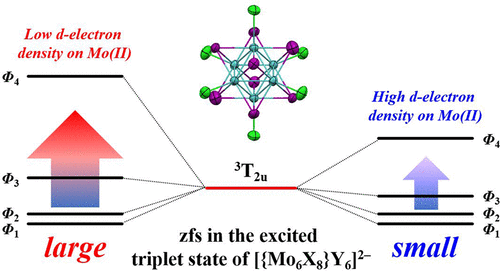当前位置:
X-MOL 学术
›
J. Phys. Chem. A
›
论文详情
Our official English website, www.x-mol.net, welcomes your feedback! (Note: you will need to create a separate account there.)
Zero-Magnetic-Field Splitting in the Excited Triplet States of Octahedral Hexanuclear Molybdenum(II) Clusters: [{Mo6X8}Y6]2– (X, Y = Cl, Br, I)
The Journal of Physical Chemistry A ( IF 2.9 ) Pub Date : 2018-10-26 00:00:00 , DOI: 10.1021/acs.jpca.8b09339 Soichiro Akagi , Sho Fujii , Noboru Kitamura
The Journal of Physical Chemistry A ( IF 2.9 ) Pub Date : 2018-10-26 00:00:00 , DOI: 10.1021/acs.jpca.8b09339 Soichiro Akagi , Sho Fujii , Noboru Kitamura

|
The temperature (T) dependences of the emissions from the tetra-n-butylammonium salts of [{Mo6X8}Y6]2– (X, Y = Cl, Br, and I) in optically transparent polyethylene glycol dimethacrylate matrixes were studied in the T range of 3–300 K. [{Mo6Cl8}Y6]2–, [{Mo6Br8}Y6]2–, and [{Mo6I8}I6]2– showed the T-dependent emission characteristics similar to those of other hexanuclear Mo(II), Re(III), and W(II) clusters reported previously, while [{Mo6I8}Br6]2– and [{Mo6I8}Cl6]2– exhibited the emission properties different from those of other [{Mo6X8}Y6]2– clusters. The photophysical behavior of these clusters was explained by the excited triplet state spin-sublevel (Φn, n = 1–4) model irrespective of the nature of X and Y. The zero-magnetic-field splitting energies between the lowest energy (Φ1) and the higher energy spin sublevels (Φ4 or Φ3) caused by the first- or second-order spin–orbit coupling, ΔE14 or ΔE13, were evaluated to be 620–870 or 50–99 cm–1, respectively. We found the linear correlation between the ΔE14 or ΔE13 value and the fourth power of the atomic number (Z) of the inner halide X: ΔE14 or ΔE13 vs {Z(X)}4 (correlation coefficient: cc = ∼ 0.999). Furthermore, we also found the correlation between ΔE14 or ΔE13 and the 95Mo NMR chemical shift of the cluster. These findings gave very important insight into the spin–orbit coupling and zero-magnetic-field splitting in the excited triplet states of transition metal complexes.
中文翻译:

八面体六核钼(II)簇的激发三重态的零磁场分裂:[{Mo 6 X 8 } Y 6 ] 2–(X,Y = Cl,Br,I)
在光学透明的聚乙二醇二甲基丙烯酸酯基质中,[{Mo 6 X 8 } Y 6 ] 2-(X,Y = Cl,Br和I)的四正丁基铵盐的排放量的温度(T)依赖性为研究了Ť的范围3-300 K. [{沫6氯8 }ÿ 6 ] 2-,[{沫6溴8 }ÿ 6 ] 2-和[{沫6我8 }我6 ] 2-显示了T依赖的发射特性类似于先前报道的其他六核Mo(II),Re(III)和W(II)团簇,而[{Mo 6 I 8 } Br 6 ] 2–和[{Mo 6 I 8 } Cl 6 ] 2–的发射性质不同于其他[{Mo 6 X 8 } Y 6 ] 2 –团簇的发射性质。这些簇的光物理行为是由激发三重态自旋分段解释(Φ Ñ,Ñ= 1-4)模型而不管最低能量之间的X和Y的零磁场分裂能量(Φ的性质1)和更高的能量自旋能级(Φ 4或Φ 3所引起的第一方)或二阶自旋轨道耦合ΔE 14或ΔE 13分别被评估为620-870或50-99 cm -1。我们发现ΔE 14或ΔE 13值与内部卤化物X的原子序数(Z)的四次方之间的线性相关性:ΔE 14或ΔE 13与{ Z(X)} 4(相关系数:cc =〜0.999)。此外,我们还发现ΔE 14或ΔE 13与簇的95 Mo NMR化学位移之间的相关性。这些发现为过渡金属配合物的激发三重态下的自旋-轨道耦合和零磁场分裂提供了非常重要的见识。
更新日期:2018-10-26
中文翻译:

八面体六核钼(II)簇的激发三重态的零磁场分裂:[{Mo 6 X 8 } Y 6 ] 2–(X,Y = Cl,Br,I)
在光学透明的聚乙二醇二甲基丙烯酸酯基质中,[{Mo 6 X 8 } Y 6 ] 2-(X,Y = Cl,Br和I)的四正丁基铵盐的排放量的温度(T)依赖性为研究了Ť的范围3-300 K. [{沫6氯8 }ÿ 6 ] 2-,[{沫6溴8 }ÿ 6 ] 2-和[{沫6我8 }我6 ] 2-显示了T依赖的发射特性类似于先前报道的其他六核Mo(II),Re(III)和W(II)团簇,而[{Mo 6 I 8 } Br 6 ] 2–和[{Mo 6 I 8 } Cl 6 ] 2–的发射性质不同于其他[{Mo 6 X 8 } Y 6 ] 2 –团簇的发射性质。这些簇的光物理行为是由激发三重态自旋分段解释(Φ Ñ,Ñ= 1-4)模型而不管最低能量之间的X和Y的零磁场分裂能量(Φ的性质1)和更高的能量自旋能级(Φ 4或Φ 3所引起的第一方)或二阶自旋轨道耦合ΔE 14或ΔE 13分别被评估为620-870或50-99 cm -1。我们发现ΔE 14或ΔE 13值与内部卤化物X的原子序数(Z)的四次方之间的线性相关性:ΔE 14或ΔE 13与{ Z(X)} 4(相关系数:cc =〜0.999)。此外,我们还发现ΔE 14或ΔE 13与簇的95 Mo NMR化学位移之间的相关性。这些发现为过渡金属配合物的激发三重态下的自旋-轨道耦合和零磁场分裂提供了非常重要的见识。


























 京公网安备 11010802027423号
京公网安备 11010802027423号